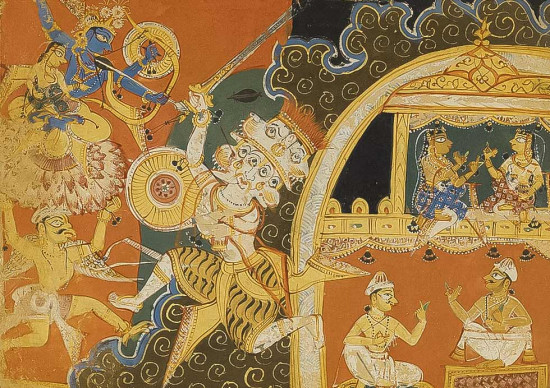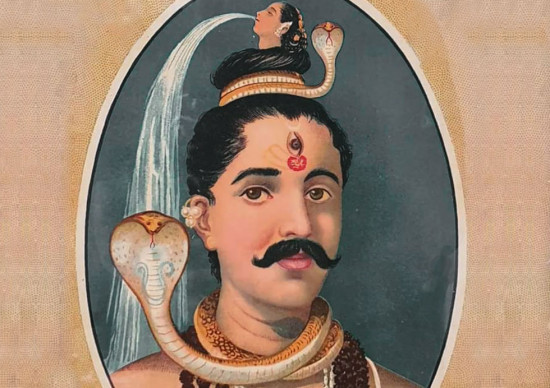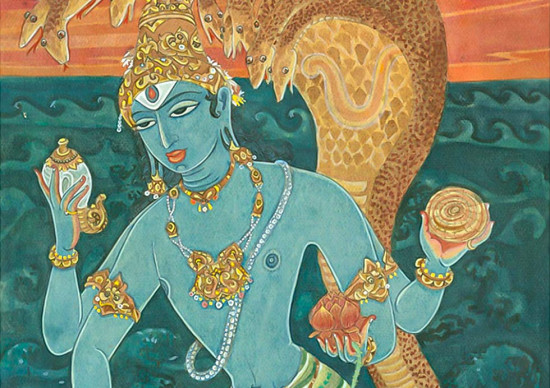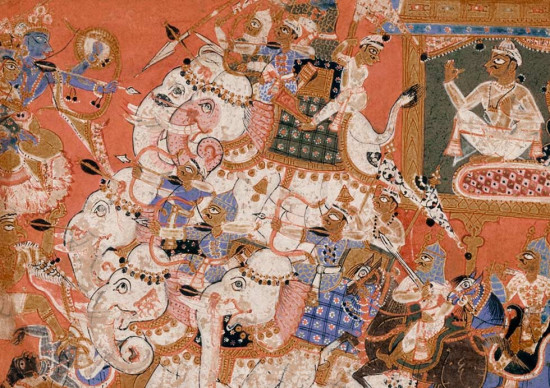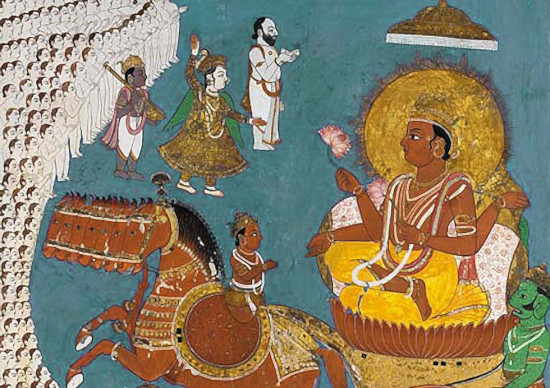The rich tapestry of Tibetan Buddhist iconography unfolds a mesmerizing display of symbols, deities, and metaphysical ideas—an expressive visual language conveying profound spiritual insights. Central to this complex artistic tradition is Padmasambhava, an esteemed figure acknowledged for spreading Buddhism in Tibet. In this blog, we embark on a detailed journey into the intricate realm of Tibetan Buddhist iconography, delving into the divine essence of Padmasambhava within this sacred artistic expression.
Padmasambhava, also recognized as Guru Rinpoche, holds a central and revered position in Tibetan Buddhism. His miraculous birth from a lotus in the Dhanakosha Lake in Oddiyana, with his name translating to “Lotus-Born” in Sanskrit, establishes him as a significant figure. As an emanation of Amitabha, the Buddha of Infinite Light, Padmasambhava is attributed with extraordinary spiritual powers, solidifying his importance in Tibetan Buddhist iconography.
Many centuries ago, Padmasambhava played a crucial role in introducing Buddhism to Tibet during the 8th century. Legend has it that he not only calmed local spirits but also sparked their interest in Buddhism. Known for his intelligence, wisdom, and kindness, Padmasambhava faced and overcame challenges, contributing to the spread of Buddhist teachings in Tibet.
A significant aspect of Padmasambhava’s legacy lies in his teachings on tantric practices, which involve secret rituals and visualizations aimed at accelerating enlightenment. These teachings continue to shape the practices of Tibetan Buddhists, particularly within the Nyingma school.
Padmasambhava initiated the tradition of “terma,” where he concealed teachings and sacred items in the environment for special individuals called treasure revealers to discover later. These teachings hold importance in various Tibetan Buddhist traditions.
In artistic depictions, Padmasambhava takes on different forms—peaceful, wrathful, or meditative—each serving distinct purposes. People turn to these forms in prayer, seeking guidance and blessings.
A significant figure in Padmasambhava’s life was Yeshe Tsogyal, his main partner and a wise yogini. Yeshe Tsogyal played a crucial role in preserving and disseminating Padmasambhava’s teachings, showcasing the complementarity of their spiritual journey.
The Nyingma school of Tibetan Buddhism highly values Padmasambhava’s teachings, considering him a guiding force towards enlightenment. Festivals and rituals dedicated to Padmasambhava are integral to honoring his impact on Tibetan Buddhism and keeping his teachings alive.
Padmasambhava, also recognized as Guru Rinpoche, holds a central and revered position in Tibetan Buddhism. His miraculous birth from a lotus in the Dhanakosha Lake in Oddiyana, with his name translating to “Lotus-Born” in Sanskrit, establishes him as a significant figure. As an emanation of Amitabha, the Buddha of Infinite Light, Padmasambhava is attributed with extraordinary spiritual powers, solidifying his importance in Tibetan Buddhist iconography.
Many centuries ago, Padmasambhava played a crucial role in introducing Buddhism to Tibet during the 8th century. Legend has it that he not only calmed local spirits but also sparked their interest in Buddhism. Known for his intelligence, wisdom, and kindness, Padmasambhava faced and overcame challenges, contributing to the spread of Buddhist teachings in Tibet.
A significant aspect of Padmasambhava’s legacy lies in his teachings on tantric practices, which involve secret rituals and visualizations aimed at accelerating enlightenment. These teachings continue to shape the practices of Tibetan Buddhists, particularly within the Nyingma school.
Padmasambhava initiated the tradition of “terma,” where he concealed teachings and sacred items in the environment for special individuals called treasure revealers to discover later. These teachings hold importance in various Tibetan Buddhist traditions.
In artistic depictions, Padmasambhava takes on different forms—peaceful, wrathful, or meditative—each serving distinct purposes. People turn to these forms in prayer, seeking guidance and blessings.
A significant figure in Padmasambhava’s life was Yeshe Tsogyal, his main partner and a wise yogini. Yeshe Tsogyal played a crucial role in preserving and disseminating Padmasambhava’s teachings, showcasing the complementarity of their spiritual journey.
The Nyingma school of Tibetan Buddhism highly values Padmasambhava’s teachings, considering him a guiding force towards enlightenment. Festivals and rituals dedicated to Padmasambhava are integral to honoring his impact on Tibetan Buddhism and keeping his teachings alive.
The Background of Tibetan Buddhist Iconography
In Tibetan Buddhism, they use a lot of pictures that are connected to Tantric Buddhism, also known as Vajrayana. This tradition really focuses on using these visual representations to help people on their spiritual journey. The detailed pictures are used for meditation, thinking deeply, and sharing secret teachings.
Padmasambhava: The Lotus-Born Guru
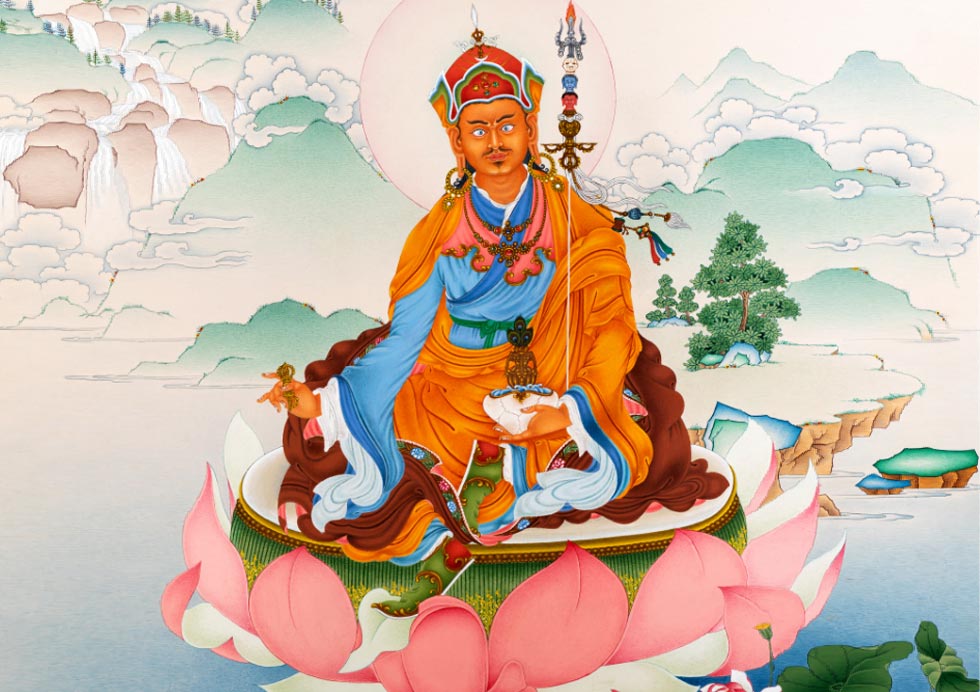
Padmasambhava, also known as Guru Rinpoche or the Lotus-Born, is a key figure in Tibetan Buddhism. According to legend, he was born from a lotus flower in the mythical land of Oddiyana, and he’s considered fully enlightened and a master of tantric practices. In the 8th century, Padmasambhava played a vital role in bringing Buddhism to Tibet. Despite facing challenges, he successfully converted local deities to Buddhism and established its presence in the region.
Padmasambhava's Iconography
Padmasambhava is often depicted seated in the vajra posture, legs crossed, with his right hand holding the vajra symbolizing skillful means and compassion. His left hand grasps a skull cup filled with the elixir of immortality, representing the harmonious union of wisdom and compassion. Adorned with symbolic ornaments like the lotus crown, five-skull crown, and bone ornaments, his intricately patterned attire signifies the sacred essence of his teachings. Portrayed within mandalas that symbolize the enlightened universe, Padmasambhava may be accompanied by consorts, such as Yeshe Tsogyal, embodying the wisdom aspect of enlightenment. This union emphasizes the integration of wisdom and skillful means. In wrathful manifestations, like Dorje Drolo, Padmasambhava exhibits formidable attributes to overcome obstacles and negative forces. Various symbols associated with him, such as the vajra and skull cup, convey transformative aspects of his teachings, emphasizing indestructible compassion and the transmutation of ordinary perception into wisdom.
The Role of Tibetan Buddhist Iconography in Practice:
In Tibetan Buddhist practice, the use of iconography extends beyond mere artistic expression; it serves as a vital tool for spiritual engagement. Delving into the depictions of deities such as Padmasambhava is more than an aesthetic exercise—it becomes a meditation, a path to directly connect with the divine attributes these figures represent. Mandalas, thangkas, and ceremonial items are not just artistic elements; they function as portals to the sacred, providing practitioners with guidance on their journey toward enlightenment.
Conclusion
In the realm of Tibetan Buddhist iconography, Padmasambhava stands as a luminous figure, guiding practitioners through the visual language of symbols and metaphors. His iconographic representations serve as sacred maps, leading the way to deeper understanding, profound meditation, and ultimately, the realization of enlightenment. As practitioners engage with these divine images, they partake in a visual journey that transcends the boundaries of the material world, unlocking the gates to spiritual transformation and awakening.

